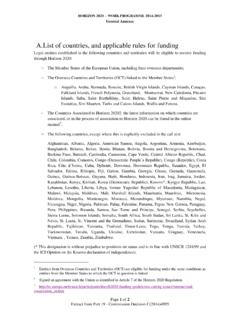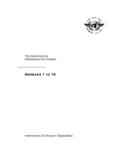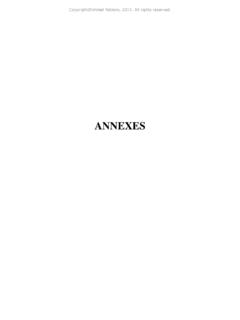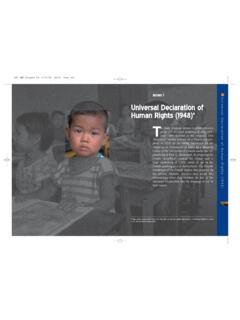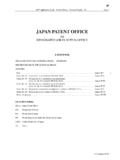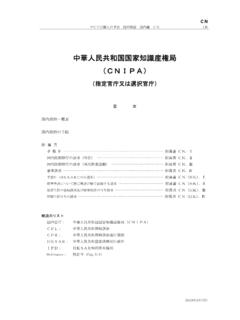Transcription of Sodium dichloroisocyanurate (NaDCC) tablets as an ...
1 Int. J. Hyg. 209 (2006) 173 181 Sodium dichloroisocyanurate (NaDCC) tablets as an alternative tosodium hypochlorite for the routine treatment of drinking water at thehousehold levelThomas Clasena, , Paul EdmondsonbaDepartment of Infectious and Tropical Diseases, London School of Hygiene & Tropical Medicine, Keppel St.,London WC1E 7HT, UKbMedentech, Ltd., Wexford, IrelandReceived 13 June 2005; received in revised form 17 November 2005; accepted 17 November 2005 AbstractHousehold water treatment using Sodium hypochlorite (NaOCl) has been recognized as a cost-effective means ofreducing the heavy burden of diarrhea and other waterborne diseases, especially among populations without access toimproved water supplies.
2 Sodium dichloroisocyanurate (NaDCC), which is widely used in emergencies, is analternative source of chlorine that may present certain advantages over NaOCl for household-based interventions indevelopment settings. We summarize the basic chemistry and possible benefits of NaDCC, and review the availableliterature concerning its safety and regulatory treatment and microbiological effectiveness. We review the evidenceconcerning NaDCC in field studies, including microbiological performance and health outcomes. Finally, we examinestudies and data to compare NaDCC with NaOCl in terms of compliance, acceptability, affordability andsustainability, and suggest areas for further Elsevier GmbH.
3 All rights :Chlorine; Household; NaDCC; Sodium hypochlorite; Sodium dichloroisocyanurate ; Water treatmentBackgroundContaminated drinking water, along with inadequatesupplies of water for personal hygiene and poorsanitation, are the main contributors to an estimated 4billion cases of diarrhoea each year causing milliondeaths, mostly among children under the age of five indeveloping countries (Kosek et al., 2003). Unsafe wateris also an important contributor to other potentiallywaterborne diseases, including typhoid, hepatitis A andE, polio and estimated billion people lack access toimproved water supplies; many more are forced to relyon supplies that are microbiologically unsafe (WorldHealth Organization (WHO), 2004).
4 While universalaccess to safe, piped-in water is an important long-termgoal, this is likely to be elusive for many years to comedue to the costs of building and maintaining suchsystems. Improving the microbiological quality ofdrinking water, particularly at the household level, iseffective in preventing diarrhoea in settings where it isendemic (Clasen et al., 2006). The WHO is promotingthe treatment of water at the household level to provideARTICLE IN $ - see front matterr2005 Elsevier GmbH. All rights Corresponding author. Tel.: +44 207 297 2916;fax: +44 207 297 (T. Clasen).a means of accelerating the health gains associated withsafe drinking water ( ).
5 A review of the available methods of treating water atthe household level found chlorination to be among themost promising in terms of effectiveness, affordabilityand potential sustainability (Sobsey, 2002). Researchhas also shown that chlorinating water in the home isone of the most cost-effective means of preventingdiarrhoeal disease (WHO, 2002;Hutton and Haller,2004). Produced and sold widely as household bleach, Sodium hypochlorite (NaOCl) is perhaps the mostaccessible, and thus potentially sustainable, of drinkingwater disinfectants. Interventions using NaOCl to treatwater at the household level have demonstrated itshealth impact in preventing diarrhoea (Quick et al.,2002;Reller et al.)
6 , 2003;Luby et al., 2004). At the sametime, uptake outside an epidemic has proved challengingeven when supported by social marketing and othercampaigns (Makutsa et al., 2001). Educational andmotivational approaches increase adoption but add toprogram cost (Quick, 2003). Program implementers arethus seeking alternatives that may be more readilyembraced by the target possible alternative is dichloroisocyanurate (NaDCC), also known as Sodium dichloro-s-triazine-trione. Widely used for the emergency treatment ofwater, NaDCC has recently been approved by theUnited States Environmental Protection Agency and theWHO for the routine treatment of drinking water. Likeother forms of chlorine, NaDCC produces hypochlor-ous acid, a well-known oxidizing agent.
7 Bound withcyanuric acid, however, the compound presents certainadvantages over NaOCl as a water disinfectant (Macedoand Barra, 2002). It may also offer other advantages interms of stability, safety, up-front cost and review compares NaDCC with NaOCl andexamines the available evidence concerning its use as apossible alternative for the routine treatment of drinkingwater by householders in low-income chemistry and potential advantages ofNaDCC over NaOClChlorine has been used as a disinfectant for thetreatment of drinking water for more than 100 years. Itis by far the most commonly used means of disinfectingwater, and its effectiveness as a microbicide has beenwidely assessed (AWWA, 2000).
8 While most conven-tional systems in developed countries treat water withchlorine gas (delivered as a liquid in pressurizedsystems), other common alternatives include calciumhypochlorite, Sodium hypochlorite, lithium hypochloriteand chloroisocyanurates ( Sodium dichloroisocyanurateor trichloroisocyanuric acid). Until recently, the iso-cyanurates were used chiefly in the disinfection of waterfor swimming pools and industrial cooling towers. Theyare also a common microbial agent in cleaning andsanitizing applications, including baby bottles andcontact lens (Dychdala, 2001).All of these compounds disinfect water by releasingfree available chlorine (FAC) in the form of hypochlor-ous acid (HOCl).
9 For example,NaOCl H2O!HOCl NaOHSodium hypochlorite dispersion in waterNaCl2 NCO 3 2H2O22 HOCl NaH2 NCO 3 NaDCC dissolution in (chlorine in the 1 oxidation state) is aneffective biocide against a wide range of bacteria, fungi,algae, and viruses (White, 1998). Regardless of theoriginal source of the available chlorine, the activemicrobicidal agent is hypochlorous acid. This alsomeans that the most common method used in the fieldto assess the safety of drinking water measuring FACusing the DPD reagent is equally applicable withrespect to water treated with both NaOCl and NaDCC rely on HOCl as theactive agent, there are important differences in theperformance of the two compounds.
10 Unlike NaOClwhich releases all of its chlorine as FAC, NaDCCreleases only approximately 50% of the chlorine asFAC, the balance remaining as reservoir chlorine (bound) in the form of chlorinated isocyanurates(Bloomfield and Miles, 1979). When the FAC is usedup, the equilibrium is disturbed, immediately releasingfurther FAC from the reservoir until the totalavailable is used up. Thus, as shown inFigs. 1 and 2,the stabilized chlorine in NaDCC acts as a reservoir ofHOCl which is rapidly released when the free availablechlorine is depleted (Kuechler, 1997, 1999).ARTICLE IN free% boundFig. and bound available chlorine in a solution of1 mg/l Clasen, P.










